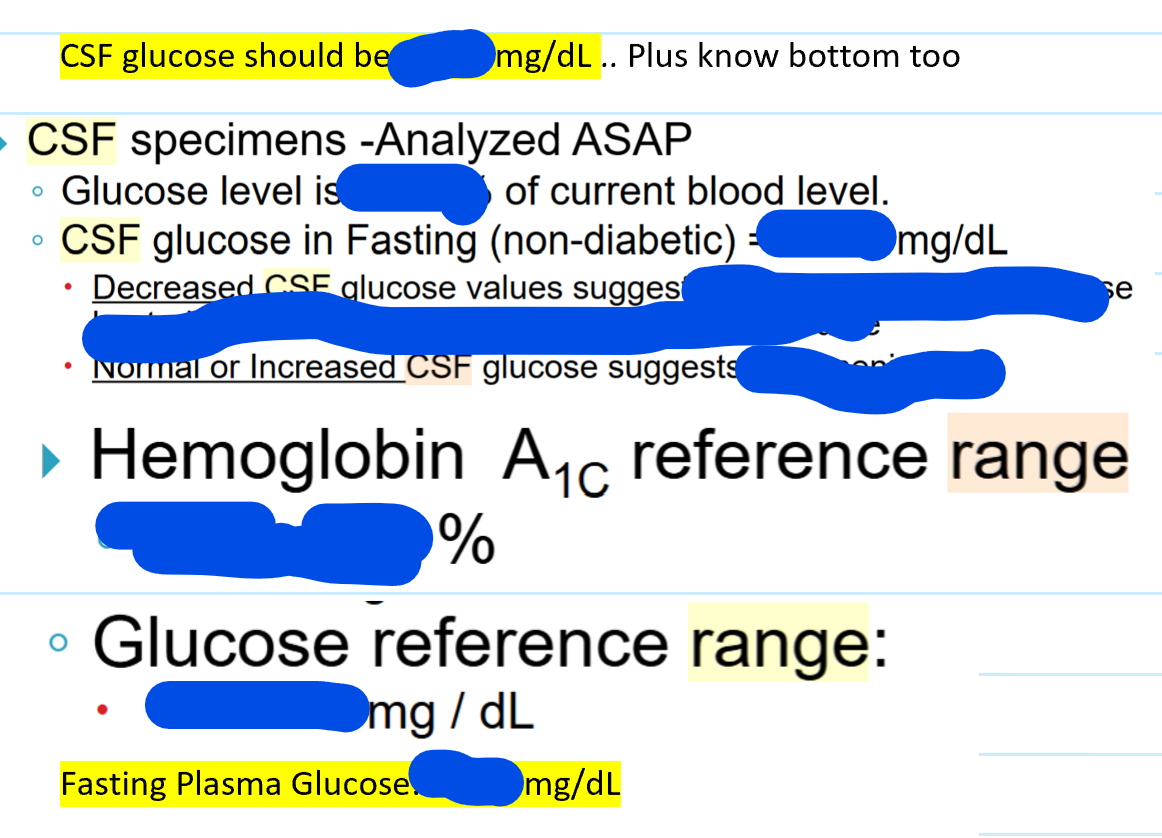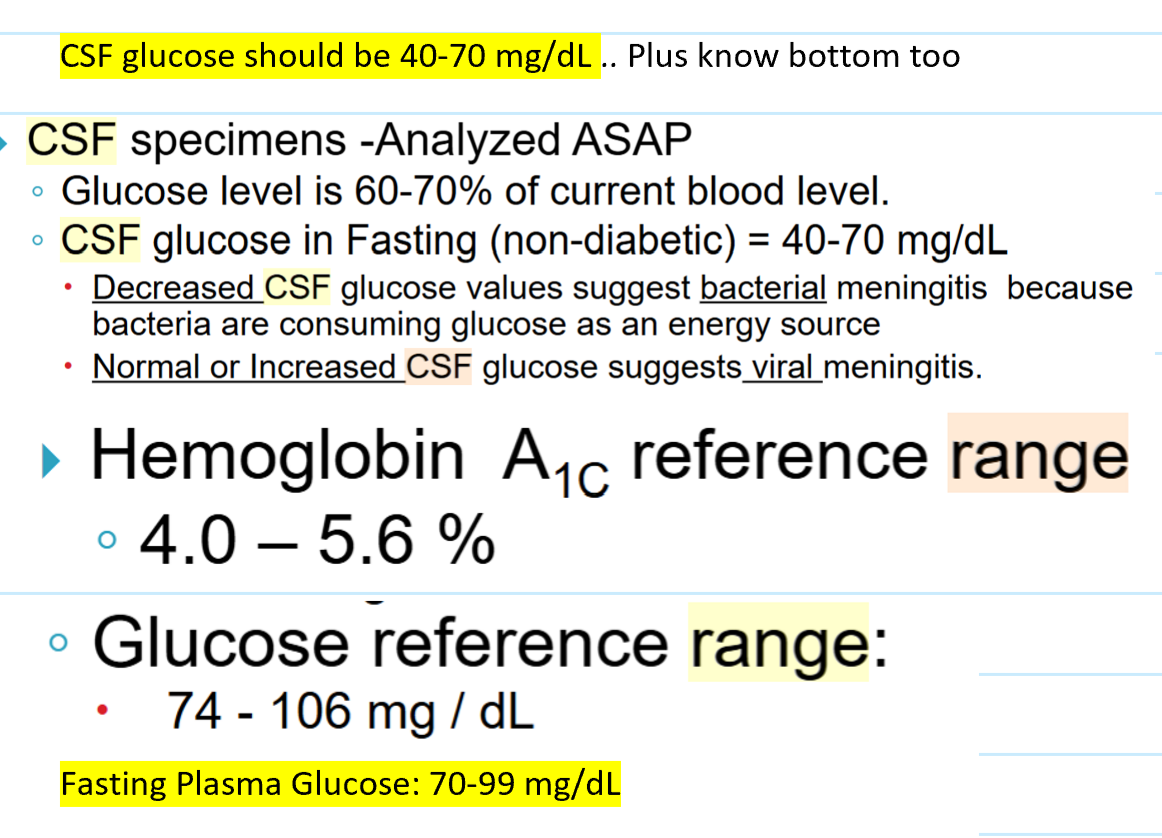W6, Lecture 6 Carbohydrates
1/32
Earn XP
Description and Tags
watch video if u want, i did not
Name | Mastery | Learn | Test | Matching | Spaced |
|---|
No study sessions yet.
33 Terms
what are carbs?
what 3 main type of food does our cell use for energy?
What are the main source of energy for our body?
what does our body store carbs as and where?
Carbs= Carbohydrates
Our cells use three main types of food for energy:
fats, proteins, and sugars/starches.
Carbs are a main source of energy for our bodies: brain, red blood cells, eyes, etc.
Our bodies store carbs as glycogen in the liver and muscles for later use.
what are carbs made out of?
difference between ketone and aldehyde?
How are carbs put into groups?
Carbs are made of:
carbon, hydrogen, oxygen
Also contains a C=O (ketone) and an R-CHO (aldehyde) functional group.
An aldehyde is a carbonyl group(C=O) that is attached to a carbon atom at the end of a carbon chain.
A ketone is which the carbonyl group (C=O) is attached to a carbon atom within the carbon chain.
Carbs are into groups based on: how long their carbon chain is, where a C=O functional group is, how many sugar units they have, and how their atoms are arranged in 3D space.
define reducing substances?
are carbs reducing substance. If so, why?
give me some examples of reducing substance and non-reducing substance?
Some (not all) carbs are reducing substances (gives away electrons)
To give away electrons, a sugar needs to have an aldehyde or ketone.
Sugars like:
glucose, maltose, lactose, fructose, and galactose can give away electrons.
Sucrose (table sugar) is not a reducing substance aka cannot give away electrons
donates electrons (oxidized), another molecule must accept them (reduced).

what is the main energy source?
How are carbohydrates broken down?
fill in the table
Glucose (sugar) is the main energy source
Carbohydrate breakdown:
Carbohydrates → Dextrins/Maltose → Monosaccharides → Liver
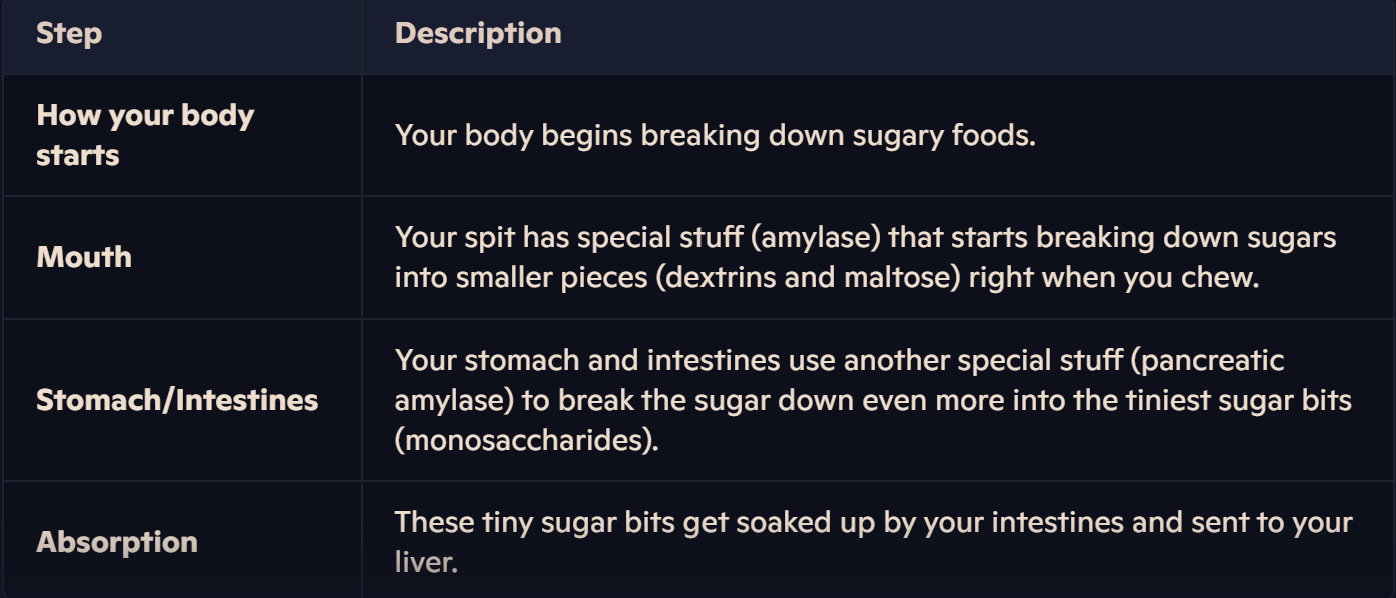
What is the main goal to turn sugar into?
what is the byproduct?
what are the possible ways that the body can use sugar?
The main goal is to turn sugar into carbon dioxide and water, with energy (ATP) as a byproduct (secondary product)
Possible ways the body can use sugar:
Your liver can turn sugar into glycogen (stored sugar) for later use.
Sugar can be used right away to make energy, turning into carbon dioxide and water and obtaining ATP as a by product
sugar can also be turned into other building blocks like keto-acids, amino acids, and proteins.
or Extra sugar can be turned into fat and stored in your fat cells.
Describe the biochemical pathways for the carbohydrate breakdown:
Embden-Meyerhoff pathway aka?
Pentose Phosphate pathway
Glycogenesis
Glycogenolysis
Gluconeogenesis
Lipogenesis
Lipolysis
All of these sum together determines what?
Embden-Meyerhoff pathway (EMP) aka Glycolysis
Converts glucose to pyruvate/lactate.
Primary energy source for humans
Glucose → Pyruvate (or Lactate under anaerobic conditions) → ATP (Energy) + NADH
The conversion of glucose into lactate or pyruvate and then CO₂ and H₂O with ATP as byproduct is called glycolysis
Pentose Phosphate pathway
Sugar that are Oxidized (lose electrons) turn it into ribose (part of DNA) and CO2 which produces (NADPH ) as a byproduct
Glycogenesis
This is the process where your body turns excess glucose (sugar) into stored sugar (glycogen) usually in liver & muscle
glucose to glycogen
glycogen is quickly accessible
Glycogenolysis
Body breaks down glycogen (stored sugar) back into glucose when your blood sugar is low.
Gluconeogenesis
when your body makes glucose (sugar) from other things like protein, fat, or other non-sugar materials, occurs mainly in the liver.
Lipogenesis
when your body turns sugar into fat for long-term energy storage.
Fat is another energy storage form, but not as quickly accessible as glycogen
Lipolysis
breakdown of fat.
All these sugar-handling processes sum together controls how much sugar is in your blood (blood glucose)
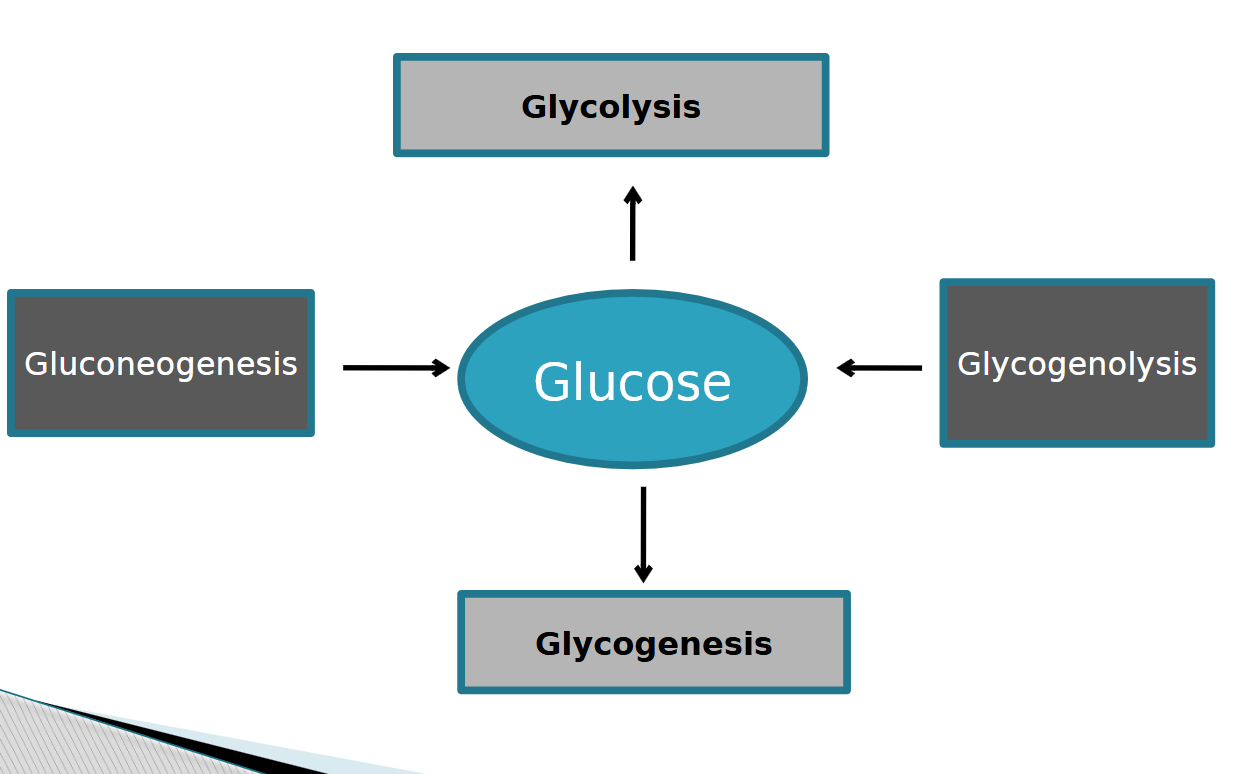
Explain the chart
define each
shows how sugar (glucose) is handled in your body:
Glycolysis:
Using sugar for energy.
Glycogenesis:
Storing extra sugar.
Glycogenolysis:
Releasing stored sugar.
Gluconeogenesis:
Making new sugar from protein, fat, or other non-sugar materials
What do these organs do with glucose regulation?
Liver
Muscles:
Pancreas
Other endocrine glands
Liver
Helps control blood sugar.
Muscles: skeletal and Heart
Muscles use and store sugar.
Pancreas
The pancreas synthesizes aka makes hormones (insulin, glucagon, somatostatin) that control blood sugar.
Other endocrine glands
Anterior pituitary gland (growth hormone)
Adrenal gland (epinephrine and cortisol)
Thyroid gland (thyroxine)
All of these also affects blood sugar.
If our plasma glucose decreases, what happens?
If our plasma glucose increases, what happens?
what hormone is the most important and only one to decrease glucose level?
1) If your blood sugar (plasma glucose) gets low
Your body breaks down stored sugar (glycogenolysis)
Liver quickly releases sugar aka glucose into your blood (quick response)
Your body also makes new sugar (gluconeogenesis) and breaks down fat (lipolysis)
2) If blood sugar is increased:
Body stores sugar aka glucose as glycogen (glycogenesis)
Body turns sugar into fat (lipogenesis)
3) Insulin
Most important & only one to decrease glucose level
Insulin is made in the Beta cells of the Islets of Langerhans (pancreas)
Insulin is released when your blood sugar is high
blood sugar aka plasma glucose
What does insulin do?
What are the effects of insulin?
there are 6
Insulin action/effects
Insulin helps sugar aka glucose get into your cell
cell membranes need insulin to be present for glucose to enter
Insulin helps your liver store sugar as glycogen.
glycogenesis = glucose to glycogen
Insulin speeds up how your cells use sugar for energy.
Insulin helps turn extra sugar into fat.
such as formation of triglycerides
Insulin helps make amino acids from sugar byproducts.
Insulin stops/decreases your body from breaking down stored sugar or making new sugar.
Glycogenolysis:
Releasing stored sugar.
Gluconeogenesis:
Making new sugar from protein, fat, or other non-sugar materials
How does your body know how much insulin to release?
what other thing affects how much insulin is released?
How much sugar is in your blood controls how much insulin is released.
Certain Amino Acids (i.e. leucine, & arginine) also affect how much insulin is released.
What does insulin do again?
Glucagon is what kind of hormone/what does it do?
where is glucagon made?
when is glucagon released?
what does glucagon promote?
Insulin decreases blood sugar/glucose
Glucagon is the second most important hormone.
Glucagon raises blood sugar
The alpha cells of the islets of Langerhans are located in the pancreas
Glucagon is made in the pancreas
Glucagon is released when blood sugar is low in order to raise blood sugar. Glucagon:
Promotes (glycogenolysis) and (gluconeogenesis).
Glycogenolysis:
Releasing stored sugar.
Gluconeogenesis:
Making new sugar from protein, fat, or other non-sugar materials
Also promotes the breakdown of protein to amino acids and the breakdown of fats
All of these happen in order to increase blood glucose levels
Tell me the location, what happens to the plasma levels, and action of these hormones:
Bonus points for what trigger these hormones
Epinephrine (Adrenaline)
Glucocorticoids (Cortisol)
Growth Hormone (GH) and Adrenocorticotropic
Hormone (ACTH)
Thyroid Hormones (Thyroxine)
Somatostatin
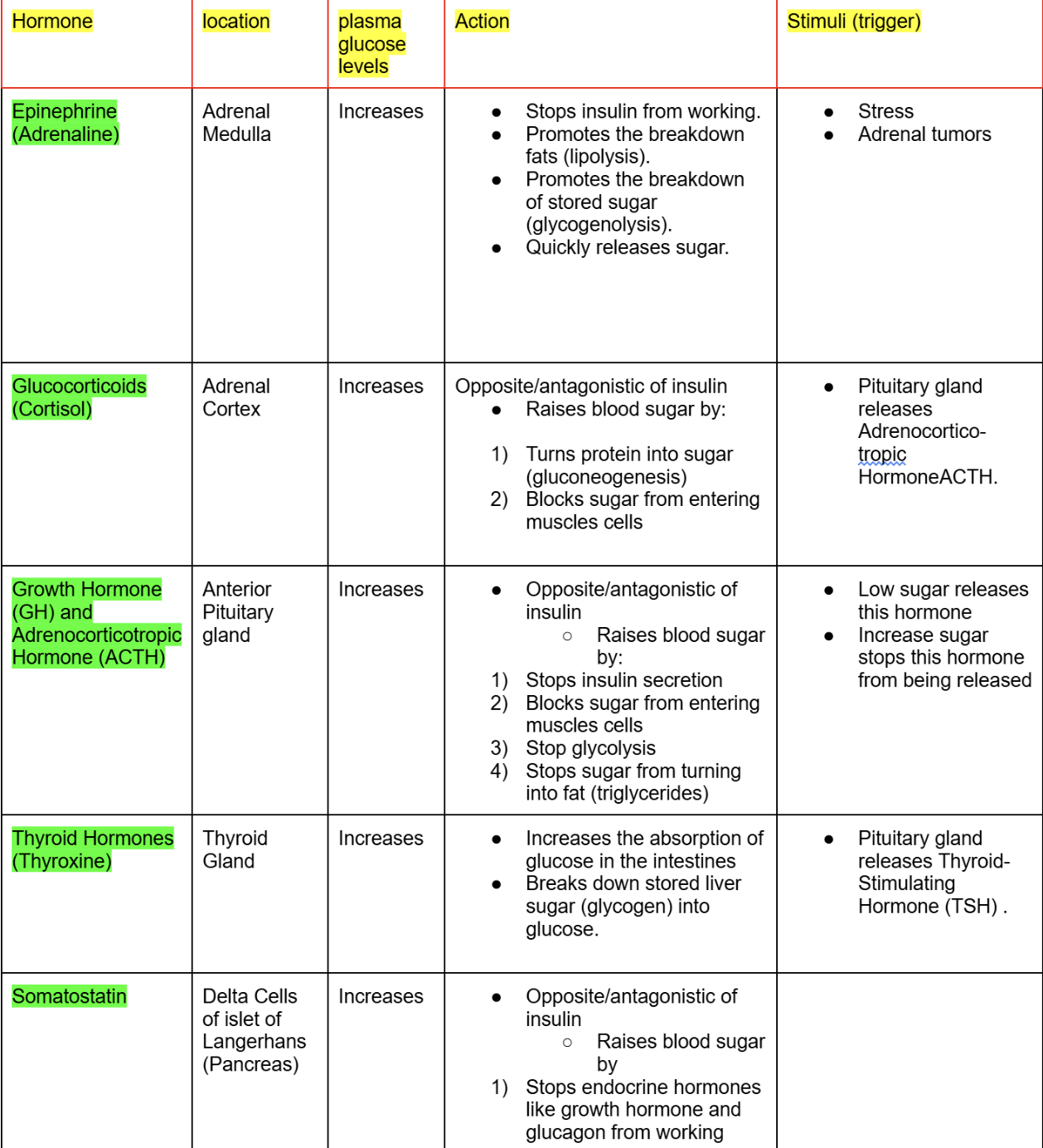
Normal blood sugar levels in serum/plasma are?
How to test for glucose?
can we use CSP?
can we use whole blood?
can we use urine?
normal blood sugar/glucose values in the serum/plasma are between 74 -106 mg/dL.
Glucose tests from the blood:
Test the blood sugar within 1 hour of taking the blood.
Separate the plasma and the cells by centrifugation since the cells keeps using up the sugar
can refrigerate to slow down this process
Use a gray top with sodium fluoride for a glucose test
Fluoride inhibits glycolysis
If one test the fluid around the brain and spinal cord (CSF), do it right away.
Low sugar level in this fluid can mean a bacterial infection
normal or high sugar level can mean a viral infection.
Whole blood is around 11% lower than plasma/serum fluid
One can also collect all the urine over 24 hours to see how much sugar is lost from the body
testing single urine sample is not used for diagnosis

Glucose oxidase method what is it?
what is the enzyme that does the first part of the reaction?
what is the second part of the reaction called?
The Glucose Oxidase Method involves using the enzyme glucose oxidase to break down glucose into gluconic acid and hydrogen peroxide (H2O2).
The Trinder Reaction focuses on the second part, the hydrogen peroxide.
In this step, hydrogen peroxide reacts with a substance (chromogen) in the presence of the enzyme peroxidase to produce a color change.
The intensity of the color tells us the amount of glucose in the sample.

what are the Limitations of the Glucose Oxidase Method and what works best with it?
what is another method to detect glucose concentration?
Glucose Oxidase Method:
Works well for blood and CSF (cerebrospinal fluid) sample
Not the best for urine since urine contains substances like ascorbic acid (Vitamin C), bilirubin, and uric acid.
these substances can also be oxidized by the enzyme Peroxidase which can give us wrong results
Alternate method called polarography:
in Polarography we allow Glucose to react with oxygen, and the amount of oxygen used up is measured with an electrode

what is hexokinase?
what is the hexokinase method?
what absorbance does it work at?
Hexokinase is an enzyme that helps attach a phosphate group to glucose (this is called phosphorylation)
The hexokinase method is super accurate since it uses very specific reactions
This test is slow, but It’s preferred for reference tests because it avoids issues (interferences) that affect the Glucose Oxidase Method
works on blood, urine, and CSF (cerebrospinal fluid) samples
The hexokinase method works by creating a molecule (NADPH) that absorbs light at 340nm.
The more light absorbed; the more glucose was in the original sample.

Tell me all you know about these laboratory test
Fasting plasma glucose (FPS)
2 Hour Postprandial
Oral Glucose Tolerance Test (OGTT)
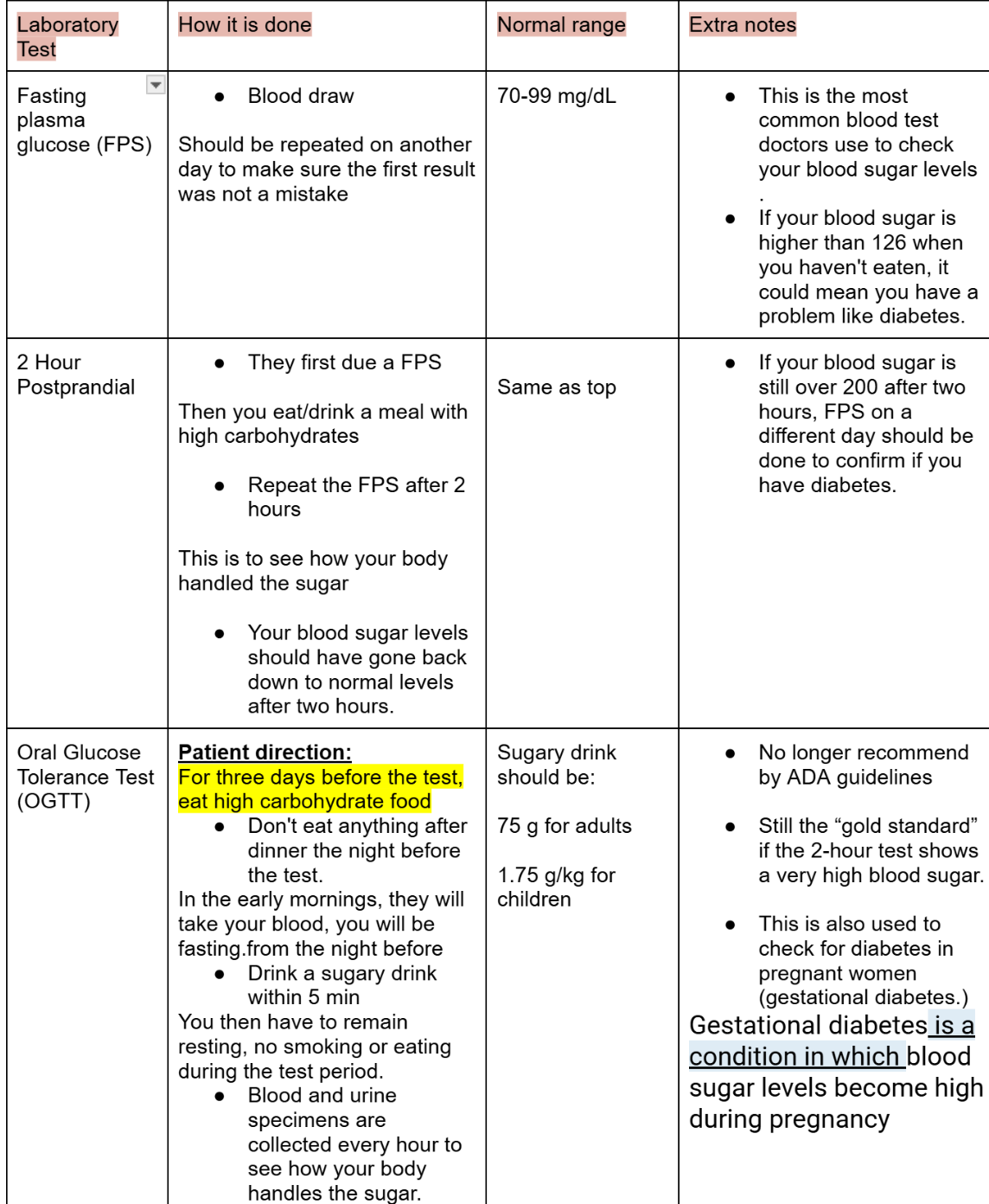
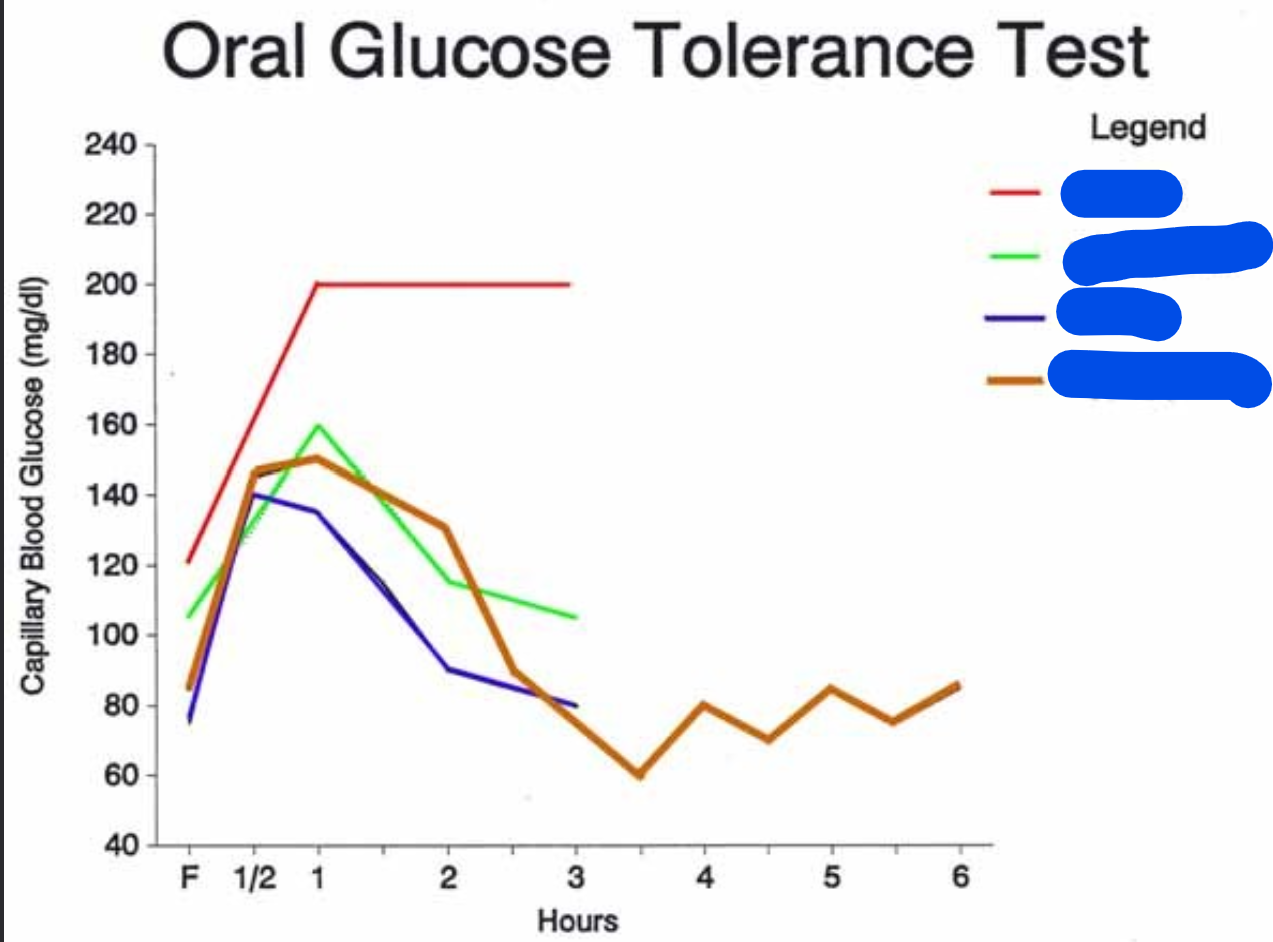
label each of the lines, here are the options:
Normal
Hypoglycemic
Diabetic
Pre-Diabetic
Hypoglycemic means low blood sugar
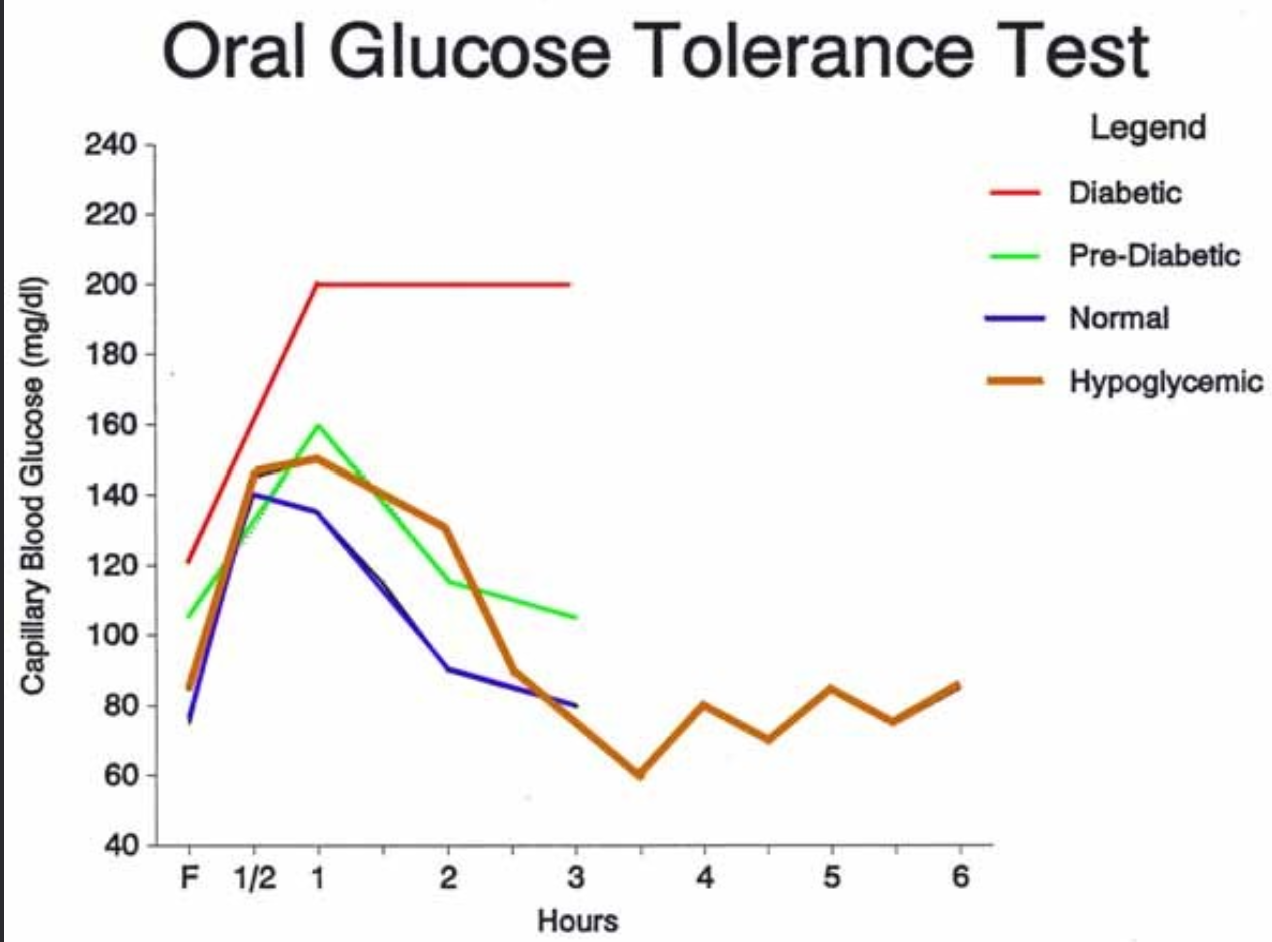
Tell me everything about these test
Ketones Test
Microalbumin Test
Glycosylated Hemoglobin aka Hemoglobin A1c Test
Lactose Tolerance Test
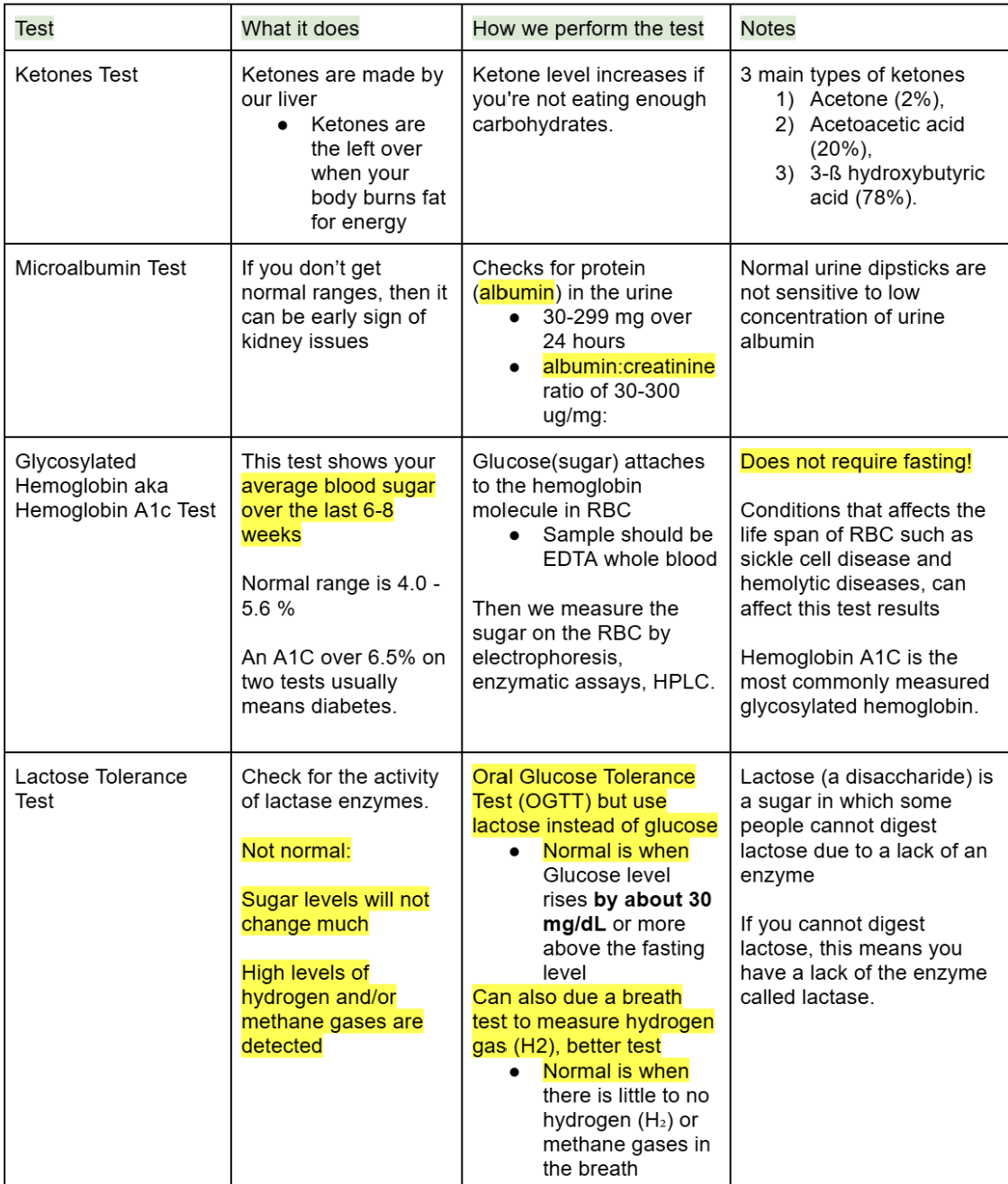
Urine glucose test which includes:
Copper Reduction- Clini-test
what does this test check?
is this test still used?
Define galactosemia
Copper Reduction- Clini-test
Detects all type of reducing sugar
is also used to check for galactosemia in babies and children < 3 yrs old
This is an older test and there are better ways to check for sugar in urine now
Reducing sugars are just sugar with a specific chemical property that allows them to be detected in tests like clini-test
Galactosemia is a rare genetic condition where the body can't break down galactose. If untreated, galactose can build up and cause problems.
Hyperglycemia is what?
why does hyperglycemia occur?
where is insulin secreted by?
Range for normal blood sugar
what is consider hyperglycemia?
Immediate effects of Hyperglycemia
Long term effects of Hyperglycemia
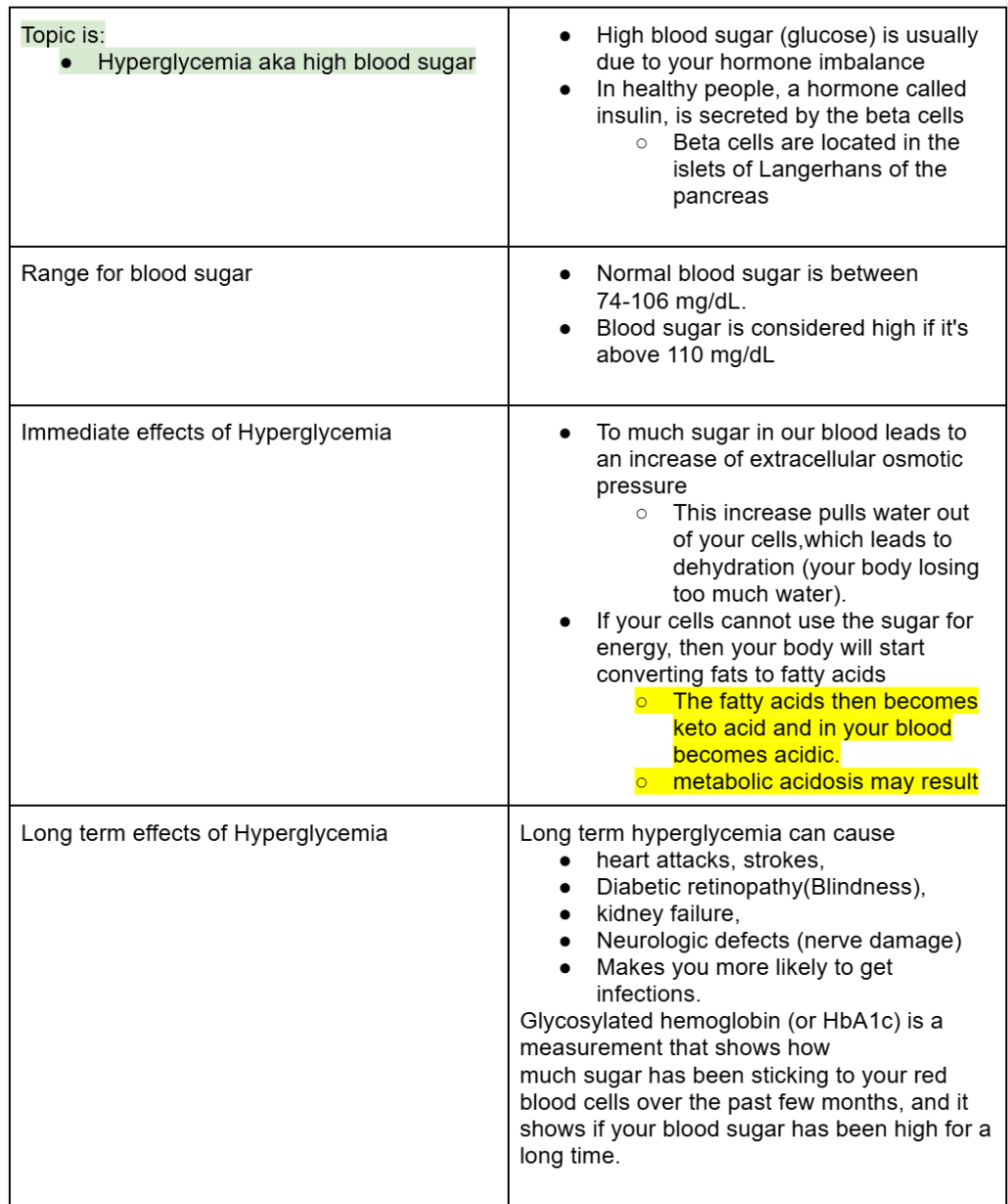
Physiological abnormalities of diabetes (changes or problems that happen in the body because of diabetes) are:
Hyperglycemia
Ketosis
Hyper-lipidemia
Decrease Blood pH leads to?
Define all of them.
Diabetes is when you have hyperglycemia aka high blood sugar.
However, there are different type of diabetes
Hyperglycemia
means high blood sugar(glucose)
doesn't matter if the sugar comes from food, burning fat, or breaking down protein, etc
Ketosis
when your body burns fat for energy, it causes ketones to build up in your blood (ketonemia) and urine (ketonuria).
Hyper-lipidemia
High blood fat levels because your body isn't using sugar properly.
Decrease blood pH - metabolic acidosis
Blood becomes acidic which causes your urine to:
Sugar in your pee (glycosuria)
peeing a lot (polyuria)
losing important salts and minerals.
4 types of diabetes are:
Type 1 (the most serious and maybe lethal)
Type 2 diabetes
Other like secondary diabetes
gestational diabetes mellitus (GDM), it's diabetes that develops during pregnancy due to hormonal changes and typically goes away after giving birth
It can increase the risk of developing Type 2 diabetes later on.
Tell me about type 1 diabetes
what does it mean
what causes it
symptoms
Lab findings
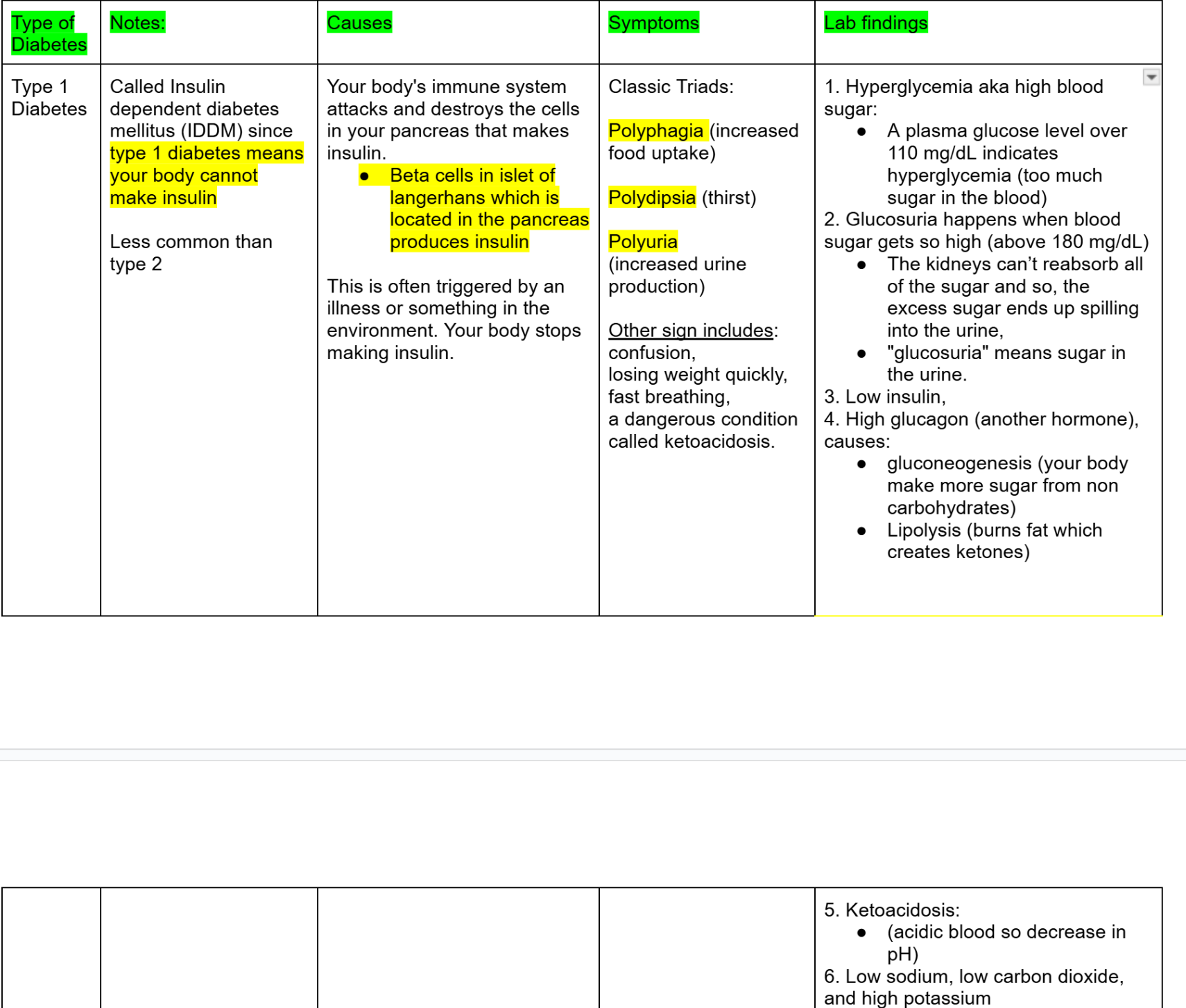
Tell me about type 2 diabetes
what does it mean
what causes it
symptoms
Lab findings
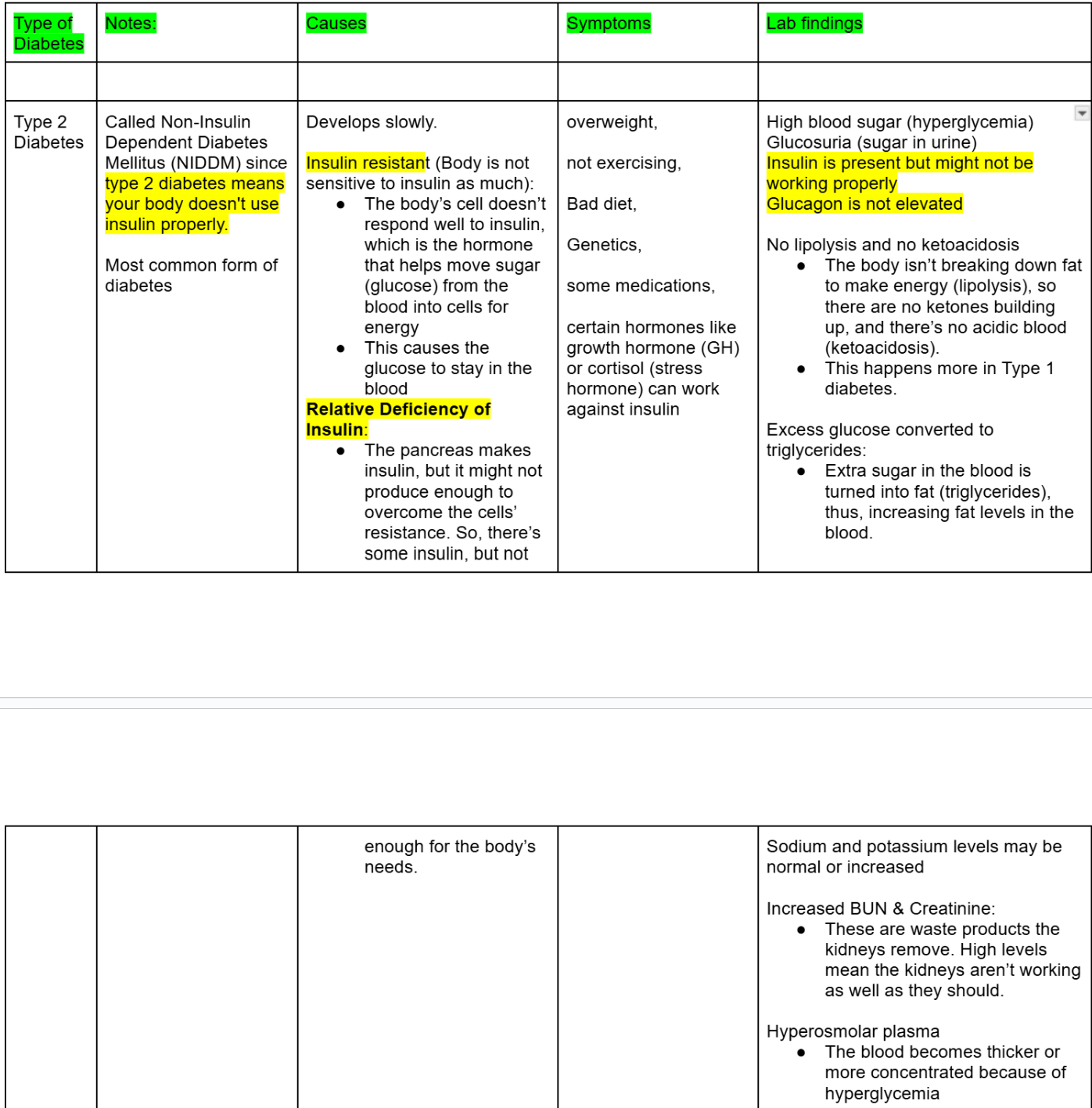
are Diabetes mellitus and Diabetes insipidus the same?
no, 2 different conditions
Diabetes mellitus:
This is what we've been discussing—it’s related to high blood sugar (hyperglycemia) because of issues with insulin
Diabetes insipidus
NOT about blood sugar!
It’s a hormone-related condition where the body struggles to regulate water, causing excessive thirst and urination
Secondary diabetes are what?
Secondary Diabetes:
diabetes that happens as a result of, or secondary to, another disease or condition
Gestational Diabetes
who is affected due to Gestational Diabetes?
Gestational Diabetes is High blood sugar that happens during pregnancy because of hormone changes.
The mother’s levels usually return to normal after pregnancy but have an increased risk for diabetes later in life
Babies born to mothers with gestational diabetes have a higher risk of respiratory complication (breathing problems) and hypoglycemia (low blood sugar) after they're born.
You have diabetes if you:
There are 4
which is preferred, long-term glucose tolerance testing (GTT) or the 2-hour test post-prandial test?
Also, would you test urine or blood for a glucose test?
If you have diabetes symptoms and your blood sugar is over 200 mg/dL at any time of day, you might have diabetes
If your blood sugar is over 126 mg/dL after not eating for 8 hours, you might have diabetes.
If your blood sugar is over 200 mg/dL two hours during an oral glucose tolerance test, you might have diabetes
If your A1c test (a measure of average blood sugar over a few months) is 6.5% or higher, u might have diabetes.
the long-term glucose tolerance testing (GTT) is not used as much
the 2-hour test post-prandial test are used instead,
post-prandial means occurring after a meal
Testing your urine for glucose (sugar) isn’t also used in diabetes diagnosis
Blood tests are better
Define hypoglycemia
what does it have to be below of
What are the symptoms of hypoglycemia?
what is whipple triad?
What is the treatment for hypoglycemia?
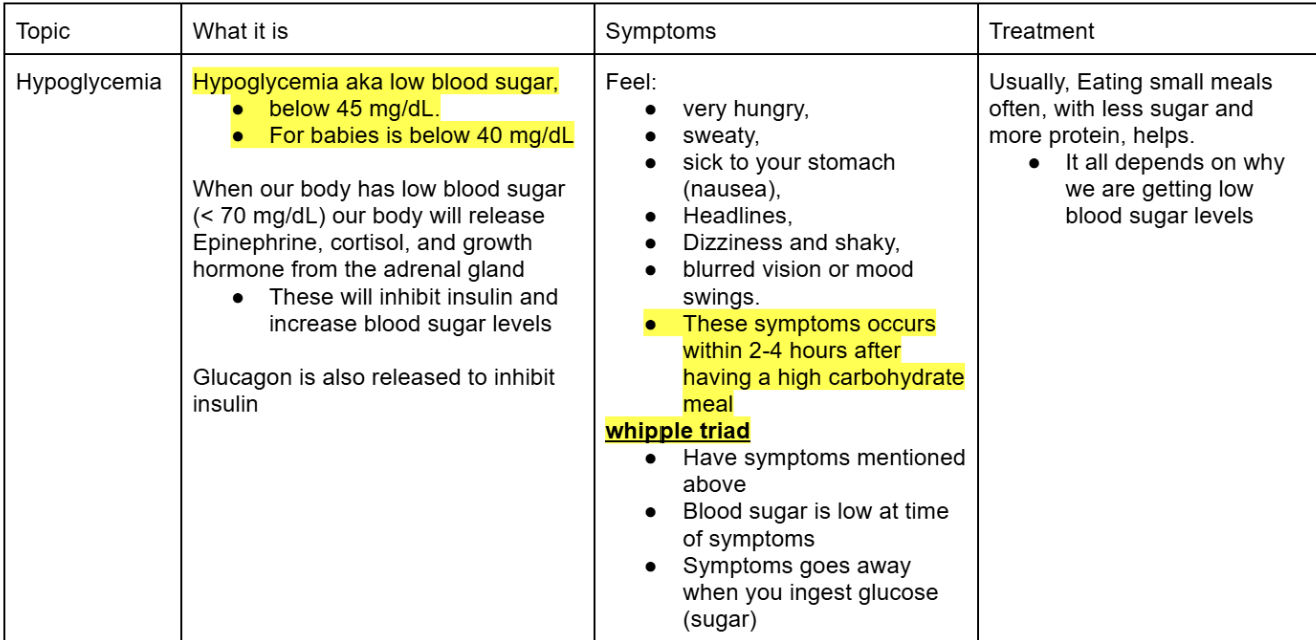
what is galactosemic
What are the symptoms if untreated?
What are the treatment

